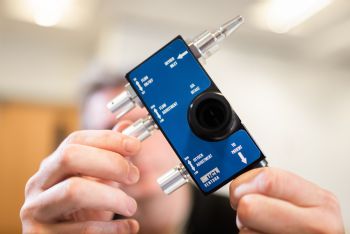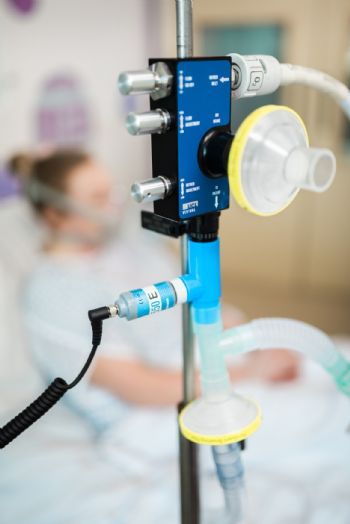
A breathing aid that can help keep coronavirus patients out of intensive care has now been recommended by the Medicines and Healthcare products Regulatory Agency (MHRA) for use in NHS hospitals.
Since 18 March, engineers at University College London (UCL) and HPP and clinicians at University College London Hospitals (UCLH) have been working round the clock at UCL’s engineering hub MechSpace to reverse engineer a device that can be produced rapidly by the thousands — it took less than 100hr from the initial meeting to production of the first device.
The breathing aid, known as Continuous Positive Airway Pressure (CPAP), has been used extensively in hospitals in Italy and China to help coronavirus patients with serious lung infections to breathe more easily, when oxygen alone is insufficient.
One hundred devices are to be delivered to UCLH for clinical trials, with rapid roll-out to hospitals around the country ahead of the predicted surge in COVID-19 hospital admissions.
The collaboration, supported by the National Institute for Health Research UCLH Biomedical Research Centre, demonstrates the way that universities, the NHS and industry are coming together to help the national response to the coronavirus pandemic, by providing vital technologies to the NHS which can enable them to care for patients who require respiratory support.
Reports from Italy indicate that approximately 50% of patients given CPAP have avoided the need for invasive mechanical ventilation — however, such devices are in short supply in UK hospitals.

UCLH critical care consultant Professor Mervyn Singer (UCL Medicine) said: “These devices will help to save lives by ensuring that ventilators, a limited resource, are used only for the most severely ill.
“While they will be tested at UCLH first, we hope they will make a real difference to hospitals across the UK by reducing demand on intensive care staff and beds, as well as helping patients recover without the need for more invasive ventilation.”
Professor Rebecca Shipley, UCL Institute of Healthcare Engineering director, said: “At UCL, we have an established ecosystem of partnerships spanning engineers, healthcare and industry ready to be mobilised in times of need.
“It has been a privilege to work closely with our clinical colleagues and with doctors leading the COVID-19 response in China and Italy.
“This close contact has helped us to define the need and respond with technology that we hope will support the NHS in the weeks and months to come.”
Professor Tim Baker (UCL Mechanical Engineering) said: “Given the urgent need, we are thankful that we were able to reduce a process that could take years down to a matter of days.
“From being given the brief, we worked all hours of the day, disassembling and analysing an off-patent device.
“Using computer simulations, we improved the device further to create a state-of-the-art version suited to mass production.
“We were privileged to be able to call on the capability of Formula One – a collaboration made possible by the close links between UCL Mechanical Engineering and HPP.”
Professor Michael Arthur, UCL President & Provost, said: “I am very proud to see UCL in collaboration with industry and international partners make such a speedy and potentially life-saving contribution to the national interest at this time of unprecedented challenge for our country and so many others around the world."
Professor David Lomas (UCL Vice Provost Health) said: “This breakthrough has the potential to save many lives and allow our frontline NHS staff to keep patients off ventilators.
“It is, quite simply, a wonderful achievement to have gone from first meeting to regulator approval in just ten days. It shows what can be done when universities, industry and hospitals join forces for the national good.”
Andy Cowell, Mercedes-AMG High Performance Powertrains managing director, said: “We have been proud to put our resources at the service of UCL to deliver the CPAP project to the highest standards and in the fastest possible timeframe.”
Andy Obeid, Chief Executive of Oxford Optronix, which will manufacture the oxygen monitors for the CPAP devices, said: “By working flat out and mobilising the support of every individual in my company as well as other small companies across the UK, we have accomplished something in five days that would normally take two years.
“I am delighted we have been able to design, develop, test and manufacture a bedside monitor that will continuously measure the concentration of oxygen being delivered to the patient and is ready for clinical trials.”

Professor Yiannis Ventikos (Head of UCL Mechanical Engineering) said: “MechSpace is where we teach our students how to design, build and test simple and complex machines using ‘state of the art’ equipment and methods.
“In this phenomenal environment, our engineers were well placed to act with speed and create critical equipment that our hospitals need.”
CPAP machines are routinely used by the NHS to support patients in hospital or at home with breathing difficulties.
They work by pushing an air-oxygen mix into the mouth and nose at a continuous rate, keeping airways open and increasing the amount of oxygen entering the lungs. Invasive ventilators deliver breaths directly into the lungs, but require heavy sedation and connection to a tube placed into the patient’s trachea (windpipe).